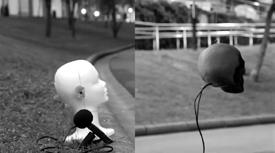
3 minute read
OIHANE IRAGUEN
OIHANE IRAGUEN - AMAIA VICENTE
(Bilbo, 1985)
Advertisement
Oihane Iraguen has a degree in Audiovisual Communication (2007) and has completed a Master’s Degree in Contemporary Technological and Performative Art and a Master’s Degree in Artistic Education (2005). She has a doctorate in Fine Arts from the University of the Basque Country, Department of Art and Technology. She in thesis (2019) she titled Acusática y encasillado. Procesos de extrañamiento contemporáneos en el arte sonoro (Acusática and pigeonholed. Contemporary estrangement processes in sound art) I study sound practice, a process/practice that promotes listening without knowing the cause of the sound. Although for Iraguen acousmatics avoids the visual field of communication, it covers its internal functioning, it acts as a black box. External stimuli affect it, triggering thoughts and emotions formed by (un) known image voices inside the box. The output given to these inputs consists of investigating the internal resonances of the black boxes if the response is not analyzed.
Oihane Iraguen est diplômée en communication audiovisuelle (2007) et a complété une maîtrise en art contemporain technologique et performatif et une maîtrise en éducation artistique (2005). Elle est titulaire d’un doctorat en Beaux-Arts de l’Université du Pays Basque, Département d’Art et de Technologie. Dans une thèse (2019) intitulée Acusática y encasillado. Procesos de extrañamiento contemporáneos en el arte sonoro (Acusática y catalogué. Processus d’éloignement contemporain dans l’art sonore) j’étudie la pratique du son, un processus/une pratique qui favorise l’écoute sans connaître la cause du son.
Si pour Iraguen l’acousmatique évite le champ visuel de la communication, elle couvre son fonctionnement interne, elle agit comme une boîte noire. Des stimuli externes l’affectent, déclenchant des pensées et des émotions formées par des voix d’image (in)connues à l’intérieur de la boîte. La sortie donnée à ces entrées consiste à rechercher les résonances internes des boîtes noires si la réponse n’est pas analysée. L’objectif de la thèse est d’analyser les pratiques sonores intermédiaires, d’investiguer les pratiques acousmatiques, de proposer le cyberféminisme comme exercice acousmatique contemporain, et d’expliquer les tournants entre l’inconnu (comprise comme boîte noire) et le connu (boîte transparente).
¡Arriba España!. 2013. Video.
Although the new laws enacted in relation to collective memory have eliminated many of the monuments and items commemorating the victors of the Spanish Civil War, the action portrayed in the video by Oihane Iraguen and Amaia Vicente reminds us that there is still much left to be done. As the artists travel down a street in Bilbao’s Doña Castilda park that is dedicated to one of the founders of the Falange, Rafael Sánchez Mazas, the victors’ military marches blaring from their loudspeakers, we are powerfully reminded that the winners of the war still have a strong public presence in our cities. It was not until 2013 that the name of this writer and politician from Bilbao (who, paradoxically, according to the book Soldados de Salamina, written by Javier Cercas and published in 2001, and the later film by David Trueba bearing the same title, narrowly managed to avoid execution thanks to a militiaman who let him escape) was removed from the park.
¡Arriba España!. 2013. Vidéo.
Même si les lois de la mémoire ont rectifié maints hommages aux vainqueurs de la guerre civile ces dernières années, l’action que reprend la vidéo d’Oihane Iraguen et Amaia Vicente nous rappelle qu’il reste encore beaucoup de chemin à faire. Le circuit des artistes, équipées d’un matériel de musique diffusant les marches militaires du camp vainqueur de la guerre, dans la rue dédiée au sein du parc de Doña Casilda de Bilbao à Rafael Sánchez Mazas, fondateur de la Phalange, fait apparaître clairement que les vainqueurs de la guerre ont encore une présence publique parmi nous. Il fallut attendre 2013 pour que soit retiré le nom de l’écrivain et politicien de Bilbao qui, paradoxalement, échappa à une exécution quasi certaine grâce à un milicien qui le laissa prendre la fuite, comme l’explique Javier Cercas dans son livre de 2001 Les Soldats de Salamine et, plus tard, David Trueba dans le film du même titre.











